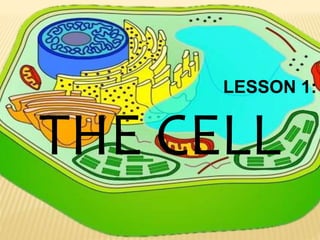Report
Share

Recommended
Recommended
More Related Content
Similar to LESSON 1.pptx
Similar to LESSON 1.pptx (20)
gen bio topic 1 topic Cell theory FOR STUDENTS.pdf

gen bio topic 1 topic Cell theory FOR STUDENTS.pdf
General Introduction of Plant Cell by Salman Saeed Lecturer Botany UCMS Khanewal

General Introduction of Plant Cell by Salman Saeed Lecturer Botany UCMS Khanewal
Recently uploaded
Ultrasound color Doppler imaging has been routinely used for the diagnosis of cardiovascular diseases, enabling real-time flow visualization through the Doppler effect. Yet, its inability to provide true flow velocity vectors due to its one-dimensional detection limits its efficacy. To overcome this limitation, various VFI schemes, including multi-angle beams, speckle tracking, and transverse oscillation, have been explored, with some already available commercially. However, many of these methods still rely on autocorrelation, which poses inherent issues such as underestimation, aliasing, and the need for large ensemble sizes. Conversely, speckle-tracking-based VFI enables lateral velocity estimation but suffers from significantly lower accuracy compared to axial velocity measurements.
To address these challenges, we have presented a speckle-tracking-based VFI approach utilizing multi-angle ultrafast plane wave imaging. Our approach involves estimating axial velocity components projected onto individual steered plane waves, which are then combined to derive the velocity vector. Additionally, we've introduced a VFI visualization technique with high spatial and temporal resolutions capable of tracking flow particle trajectories.
Simulation and flow phantom experiments demonstrate that the proposed VFI method outperforms both speckle-tracking-based VFI and autocorrelation VFI counterparts by at least a factor of three. Furthermore, in vivo measurements on carotid arteries using the Prodigy ultrasound scanner demonstrate the effectiveness of our approach compared to existing methods, providing a more robust imaging tool for hemodynamic studies.
Learning objectives:
- Understand fundamental limitations of color Doppler imaging.
- Understand principles behind advanced vector flow imaging techniques.
- Familiarize with the ultrasound speckle tracking technique and its implications in flow imaging.
- Explore experiments conducted using multi-angle plane wave ultrafast imaging, specifically utilizing the pulse-sequence mode on a 128-channel ultrasound research platform. (May 9, 2024) Enhanced Ultrafast Vector Flow Imaging (VFI) Using Multi-Angle ...

(May 9, 2024) Enhanced Ultrafast Vector Flow Imaging (VFI) Using Multi-Angle ...Scintica Instrumentation
Antibiotics are medicines that fight infections caused by bacteria in humans and animals by either killing the bacteria or making it difficult for the bacteria to grow and multiply. Bacteria are germsABHISHEK ANTIBIOTICS PPT MICROBIOLOGY // USES OF ANTIOBIOTICS TYPES OF ANTIB...

ABHISHEK ANTIBIOTICS PPT MICROBIOLOGY // USES OF ANTIOBIOTICS TYPES OF ANTIB...ABHISHEK SONI NIMT INSTITUTE OF MEDICAL AND PARAMEDCIAL SCIENCES , GOVT PG COLLEGE NOIDA
Recently uploaded (20)
Role of AI in seed science Predictive modelling and Beyond.pptx

Role of AI in seed science Predictive modelling and Beyond.pptx
POGONATUM : morphology, anatomy, reproduction etc.

POGONATUM : morphology, anatomy, reproduction etc.
Thyroid Physiology_Dr.E. Muralinath_ Associate Professor

Thyroid Physiology_Dr.E. Muralinath_ Associate Professor
Efficient spin-up of Earth System Models usingsequence acceleration

Efficient spin-up of Earth System Models usingsequence acceleration
LUNULARIA -features, morphology, anatomy ,reproduction etc.

LUNULARIA -features, morphology, anatomy ,reproduction etc.
X-rays from a Central “Exhaust Vent” of the Galactic Center Chimney

X-rays from a Central “Exhaust Vent” of the Galactic Center Chimney
GBSN - Microbiology (Unit 3)Defense Mechanism of the body 

GBSN - Microbiology (Unit 3)Defense Mechanism of the body
(May 9, 2024) Enhanced Ultrafast Vector Flow Imaging (VFI) Using Multi-Angle ...

(May 9, 2024) Enhanced Ultrafast Vector Flow Imaging (VFI) Using Multi-Angle ...
Climate Change Impacts on Terrestrial and Aquatic Ecosystems.pptx

Climate Change Impacts on Terrestrial and Aquatic Ecosystems.pptx
Module for Grade 9 for Asynchronous/Distance learning

Module for Grade 9 for Asynchronous/Distance learning
Site specific recombination and transposition.........pdf

Site specific recombination and transposition.........pdf
ABHISHEK ANTIBIOTICS PPT MICROBIOLOGY // USES OF ANTIOBIOTICS TYPES OF ANTIB...

ABHISHEK ANTIBIOTICS PPT MICROBIOLOGY // USES OF ANTIOBIOTICS TYPES OF ANTIB...
LESSON 1.pptx
- 2. WHAT IS CELL? It is the basic unit of life. Robert Hooke discovered cell in 1665. Anton van Leeuwenhoek-animalcules
- 4. FIRST POSTULATE: The cell is the basic unit of life.
- 5. SECOND POSTULATE: All living things are composed of cells.
- 6. THIRD POSTULATE: New cells are created from preexisting
- 8. 1590 – ZACHARIAS JANSSEN, invented the primitive microscope. 1663-1665 – ROBERT HOOKE, used corks and observed hollow, small structures and called it cells. 1665-1676 – MARCELLO MALPIGHI and NEHEMIAH GREW, conducted separate investigation on plant cells and determined the presence of organelles within its cells.
- 9. 1670-1683 – ANTON VAN LEEUWENHOEK, upgraded Janssen’s microscope and produced his own lens. 1831 – ROBERT BROWN, discovered the NUCLEUS. 1838 – MATTHIAS SCHLEIDEN, recognized that plant parts came from cells. 1839 – THEODOR SCHWANN, declared that animals are also composed of cells.
- 10. 1840 – ALBRECHT VON ROELLIKER, stated that sperm and egg are composed of cells and that all humans are configured from cells. 1849 – LOUIS PASTEUR, developed fermentation. 1858 – RUDOLF VIRCHOW, “Omnis cellula e cellula”